Methane Emissions from Wetlands on the Tibetan Plateau over the Past 40 Years
Abstract
1. Introduction
2. Materials and Methods
2.1. Study Area
2.2. Inventory Data
2.3. Multisource Remote Sensing Dataset
2.4. Land Surface Models
3. Method
3.1. Upscaling of In Situ to Plateau via Machine Learning
3.2. Data Preprocessing and Model Validation
3.3. Model Data Comparison
4. Results and Discussion
4.1. Developing a Data-Driven Approach to Estimate Plateau-Scale CH4 Emission
4.2. Spatio-Temporal Pattern of Wetland CH4 Emissions During 1979–2015
4.3. Evaluation of Modeled CH4 Emissions
4.4. Future Projections of CH4 Emissions from TP Wetlands
5. Conclusions
Author Contributions
Funding
Data Availability Statement
Conflicts of Interest
References
- Gedney, N.; Huntingford, C.; Comyn-Platt, E.; Wiltshire, A. Significant feedbacks of wetland methane release on climate change and the causes of their uncertainty. Environ. Res. Lett. 2019, 14, 084027. [Google Scholar] [CrossRef]
- Bridgham, S.D.; Cadillo-Quiroz, H.; Keller, J.K.; Zhuang, Q. Methane emissions from wetlands: Biogeochemical, microbial, and modeling perspectives from local to global scales. Glob. Change Biol. 2013, 19, 1325–1346. [Google Scholar] [CrossRef]
- Saunois, M.; Stavert, A.R.; Poulter, B.; Bousquet, P.; Canadell, J.G.; Jackson, R.B.; Raymond, P.A.; Dlugokencky, E.J.; Houweling, S.; Patra, P.K.; et al. The global methane budget 2000–2017. Earth Syst. Sci. Data 2020, 12, 1561–1623. [Google Scholar] [CrossRef]
- Zhang, Z.; Zimmermann, N.E.; Stenke, A.; Li, X.; Hodson, E.L.; Zhu, G.; Huang, C.; Poulter, B. Emerging role of wetland methane emissions in driving 21st century climate change. Proc. Natl. Acad. Sci. USA 2017, 114, 9647–9652. [Google Scholar] [CrossRef]
- Chang, K.-Y.; Riley, W.J.; Knox, S.H.; Jackson, R.B.; McNicol, G.; Poulter, B.; Aurela, M.; Baldocchi, D.; Bansal, S.; Bohrer, G.; et al. Substantial hysteresis in emergent temperature sensitivity of global wetland CH4 emissions. Nat. Commun. 2021, 12, 2266. [Google Scholar] [CrossRef]
- Hua, T.; Zhao, W.; Cherubini, F.; Hu, X.; Pereira, P. Sensitivity and future exposure of ecosystem services to climate change on the Tibetan Plateau of China. Landsc. Ecol. 2021, 36, 3451–3471. [Google Scholar] [CrossRef]
- Yao, T.; Bolch, T.; Chen, D.; Gao, J.; Immerzeel, W.; Piao, S.; Su, F.; Thompson, L.; Wada, Y.; Wang, L.; et al. The imbalance of the Asian water tower. Nat. Rev. Earth Environ. 2022, 3, 618–632. [Google Scholar] [CrossRef]
- Song, W.; Wang, H.; Wang, G.; Chen, L.; Jin, Z.; Zhuang, Q.; He, J. Methane emissions from an alpine wetland on the Tibetan Plateau: Neglected but vital contribution of the nongrowing season. J. Geophys. Res. Biogeosci. 2015, 120, 1475–1490. [Google Scholar] [CrossRef]
- Gedney, N.; Cox, P.; Huntingford, C. Climate feedback from wetland methane emissions. Geophys. Res. Lett. 2004, 31, 421–422. [Google Scholar] [CrossRef]
- Salimi, S.; Almuktar, S.A.; Scholz, M. Impact of climate change on wetland ecosystems: A critical review of experimental wetlands. J. Environ. Manag. 2021, 286, 112160. [Google Scholar] [CrossRef] [PubMed]
- Zhang, X.; Jiang, H. Spatial variations in methane emissions from natural wetlands in China. Int. J. Environ. Sci. Technol. 2014, 11, 77–86. [Google Scholar] [CrossRef]
- Li, T.; Li, H.; Zhang, Q.; Ma, Z.; Yu, L.; Lu, Y.; Niu, Z.; Sun, W.; Liu, J. Prediction of CH4 emissions from potential natural wetlands on the Tibetan Plateau during the 21st century. Sci. Total Environ. 2019, 657, 498–508. [Google Scholar] [CrossRef]
- Wei, D.; Ri, X.; Tarchen, T.; Dai, D.; Wang, Y.; Wang, Y. Revisiting the role of CH4 emissions from alpine wetlands on the Tibetan Plateau: Evidence from two in situ measurements at 4758 and 4320 m above sea level. J. Geophys. Res. Biogeosci. 2015, 120, 1741–1750. [Google Scholar] [CrossRef]
- Wei, D.; Wang, X. Uncertainty and dynamics of natural wetland CH4 release in China: Research status and priorities. Atmos. Environ. 2017, 154, 95–105. [Google Scholar] [CrossRef]
- Wang, J.; Zhu, Q.; Yang, Y.; Zhang, X.; Zhang, J.; Yuan, M.; Chen, H.; Peng, C. High uncertainties detected in the wetlands distribution of the Qinghai–Tibet Plateau based on multisource data. Landsc. Ecol. Eng. 2020, 16, 47–61. [Google Scholar] [CrossRef]
- Lorente, A.; Borsdorff, T.; Butz, A.; Hasekamp, O.; de Brugh, J.A.; Schneider, A.; Wu, L.; Hase, F.; Kivi, R.; Wunch, D.; et al. Methane retrieved from TROPOMI: Improvement of the data product and validation of the first 2 years of measurements. Atmos. Meas. Tech. 2021, 14, 665–684. [Google Scholar] [CrossRef]
- Peng, S.; Lin, X.; Thompson, R.L.; Xi, Y.; Liu, G.; Hauglustaine, D.; Lan, X.; Poulter, B.; Ramonet, M.; Saunois, M.; et al. Wetland emission and atmospheric sink changes explain methane growth in 2020. Nature 2022, 612, 477–482. [Google Scholar] [CrossRef]
- Arneth, A.; Harrison, S.P.; Zaehle, S.; Tsigaridis, K.; Menon, S.; Bartlein, P.J.; Feichter, J.; Korhola, A.; Kulmala, M.; O’DOnnell, D.; et al. Terrestrial biogeochemical feedbacks in the climate system. Nat. Geosci. 2010, 3, 525–532. [Google Scholar] [CrossRef]
- Zhang, Z.; E Zimmermann, N.; Calle, L.; Hurtt, G.; Chatterjee, A.; Poulter, B. Enhanced response of global wetland methane emissions to the 2015–2016 El Niño-Southern Oscillation event. Environ. Res. Lett. 2018, 13, 074009. [Google Scholar] [CrossRef]
- Zhu, Q.; Peng, C.; Ciais, P.; Jiang, H.; Liu, J.; Bousquet, P.; Li, S.; Chang, J.; Fang, X.; Zhou, X.; et al. Interannual variation in methane emissions from tropical wetlands triggered by repeated El Niño Southern Oscillation. Glob. Change Biol. 2017, 23, 4706–4716. [Google Scholar] [CrossRef]
- Shaw, J.T.; Allen, G.; Barker, P.; Pitt, J.R.; Pasternak, D.; Bauguitte, S.J.; Lee, J.; Bower, K.N.; Daly, M.C.; Lunt, M.F.; et al. Large methane emission fluxes observed from tropical wetlands in Zambia. Glob. Biogeochem. Cycles 2022, 36, e2021GB007261. [Google Scholar] [CrossRef]
- Parker, R.J.; Wilson, C.; Bloom, A.A.; Comyn-Platt, E.; Hayman, G.; McNorton, J.; Boesch, H.; Chipperfield, M.P. Exploring constraints on a wetland methane emission ensemble (WetCHARTs) using GOSAT observations. Biogeosciences 2020, 17, 5669–5691. [Google Scholar] [CrossRef]
- Bohn, T.J.; Melton, J.R.; Ito, A.; Kleinen, T.; Spahni, R.; Stocker, B.D.; Zhang, B.; Zhu, X.; Schroeder, R.; Glagolev, M.V.; et al. WETCHIMP-WSL: Intercomparison of wetland methane emissions models over West Siberia. Biogeosciences 2015, 12, 3321–3349. [Google Scholar] [CrossRef]
- Melton, J.R.; Wania, R.; Hodson, E.L.; Poulter, B.; Ringeval, B.; Spahni, R.; Bohn, T.; Avis, C.A.; Beerling, D.J.; Chen, G.; et al. Present state of global wetland extent and wetland methane modelling: Conclusions from a model inter-comparison project (WETCHIMP). Biogeosciences 2013, 10, 753–788. [Google Scholar] [CrossRef]
- Mao, D.; Wang, Z.; Du, B.; Li, L.; Tian, Y.; Jia, M.; Zeng, Y.; Song, K.; Jiang, M.; Wang, Y. National wetland mapping in China: A new product resulting from object-based and hierarchical classification of Landsat 8 OLI images. ISPRS J. Photogramm. Remote Sens. 2020, 164, 11–25. [Google Scholar] [CrossRef]
- Niu, Z.; Zhang, H.; Wang, X.; Yao, W.; Zhou, D.; Zhao, K.; Zhao, H.; Li, N.; Huang, H.; Li, C.; et al. Mapping wetland changes in China between 1978 and 2008. Chin. Sci. Bull. 2012, 57, 2813–2823. [Google Scholar] [CrossRef]
- Mu, C.; Mu, M.; Wu, X.; Jia, L.; Fan, C.; Peng, X.; Ping, C.L.; Wu, Q.; Xiao, C.; Liu, J. High carbon emissions from thermokarst lakes and their determinants in the Tibet Plateau. Glob. Change Biol. 2023, 29, 2732–2745. [Google Scholar] [CrossRef] [PubMed]
- Allen, G.H.; Pavelsky, T.M. Global extent of rivers and streams. Science 2018, 361, 585–588. [Google Scholar] [CrossRef]
- Lang, Q.; Niu, Z.; Hong, X.; Yang, X. Remote Sensing Monitoring and Change Analysis of Wetlands in the Tibetan Plateau. Geomat. Inf. Sci. Wuhan Univ. 2021, 46, 8. [Google Scholar]
- He, L.; Rodrigues, J.L.M.; Soudzilovskaia, N.A.; Barceló, M.; Olsson, P.A.; Song, C.; Tedersoo, L.; Yuan, F.; Yuan, F.; Lipson, D.A.; et al. Global biogeography of fungal and bacterial biomass carbon in topsoil. Soil Biol. Biochem. 2020, 151, 108024. [Google Scholar] [CrossRef]
- Abatzoglou, J.T.; Dobrowski, S.Z.; Parks, S.A.; Hegewisch, K.C. TerraClimate, a high-resolution global dataset of monthly climate and climatic water balance from 1958–2015. Sci. Data 2018, 5, 170191. [Google Scholar] [CrossRef] [PubMed]
- Poggio, L.; de Sousa, L.M.; Batjes, N.H.; Heuvelink, G.B.M.; Kempen, B.; Ribeiro, E.; Rossiter, D. SoilGrids 2.0: Producing soil information for the globe with quantified spatial uncertainty. Soil 2021, 7, 217–240. [Google Scholar] [CrossRef]
- Yan, D.; Zheng, X.; Feng, M.; Liang, S.; Hu, Z.; Kuang, X.; Feng, Y. Frozen Ground Change Data Set in the Tibetan Plateau (1961–2020); National Tibetan Plateau/Third Pole Environment Data Center: Beijing, China, 2023; pp. 17–240. [Google Scholar]
- Wania, R.; Melton, J.R.; Hodson, E.L.; Poulter, B.; Ringeval, B.; Spahni, R.; Bohn, T.; Avis, C.A.; Chen, G.; Eliseev, A.V.; et al. Present state of global wetland extent and wetland methane modelling: Methodology of a model inter-comparison project (WETCHIMP). Geosci. Model Dev. 2013, 6, 617–641. [Google Scholar] [CrossRef]
- Xu, X.F.; Tian, H.Q.; Zhang, C.; Liu, M.L.; Ren, W.; Chen, G.S.; Lu, C.Q.; Bruhwiler, L. Attribution of spatial and temporal variations in terrestrial methane flux over North America. Biogeosciences 2010, 7, 3637–3655. [Google Scholar] [CrossRef]
- Harris, I.; Osborn, T.J.; Jones, P.; Lister, D. Version 4 of the CRU TS monthly high-resolution gridded multivariate climate dataset. Sci. Data 2020, 7, 109. [Google Scholar] [CrossRef] [PubMed]
- Zhang, Z.; Fluet-Chouinard, E.; Jensen, K.; McDonald, K.; Hugelius, G.; Gumbricht, T.; Carroll, M.; Prigent, C.; Bartsch, A.; Poulter, B. Development of a global synthetic map of Wetland Area and Dynamics for Methane Modeling (WAD2M). Earth Syst. Sci. Data 2021, 13, 2001–2023. [Google Scholar] [CrossRef]
- Arora, V.K.; Melton, J.R.; Plummer, D. An assessment of natural methane fluxes simulated by the CLASS-CTEM model. Biogeosciences 2018, 15, 4683–4709. [Google Scholar] [CrossRef]
- Riley, W.J.; Subin, Z.M.; Lawrence, D.M.; Swenson, S.C.; Torn, M.S.; Meng, L.; Mahowald, N.M.; Hess, P. Barriers to predicting changes in global terrestrial methane fluxes: Analyses using CLM4Me, a methane biogeochemistry model integrated in CESM. Biogeosciences 2011, 8, 1925–1953. [Google Scholar] [CrossRef]
- Kleinen, T.; Mikolajewicz, U.; Brovkin, V. Terrestrial methane emissions from the Last Glacial Maximum to the preindustrial period. Clim. Past 2020, 16, 575–595. [Google Scholar] [CrossRef]
- Hayman, G.D.; O’COnnor, F.M.; Dalvi, M.; Clark, D.B.; Gedney, N.; Huntingford, C.; Prigent, C.; Buchwitz, M.; Schneising, O.; Burrows, J.P.; et al. Comparison of the HadGEM2 climate-chemistry model against in situ and SCIAMACHY atmospheric methane data. Atmos. Chem. Phys. 2014, 14, 13257–13280. [Google Scholar] [CrossRef]
- Kleinen, T.; Brovkin, V.; Schuldt, R.J. A dynamic model of wetland extent and peat accumulation: Results for the Holocene. Biogeosciences 2012, 9, 235–248. [Google Scholar] [CrossRef]
- Zhang, Z.; Zimmermann, N.E.; Kaplan, J.O.; Poulter, B. Modeling spatiotemporal dynamics of global wetlands: Comprehensive evaluation of a new sub-grid TOPMODEL parameterization and uncertainties. Biogeosciences 2016, 13, 1387–1408. [Google Scholar] [CrossRef]
- Spahni, R.; Wania, R.; Neef, L.; van Weele, M.; Pison, I.; Bousquet, P.; Frankenberg, C.; Foster, P.N.; Joos, F.; Prentice, I.C.; et al. Constraining global methane emissions and uptake by ecosystems. Biogeosciences 2011, 8, 1643–1665. [Google Scholar] [CrossRef]
- Ringeval, B.; Friedlingstein, P.; Koven, C.; Ciais, P.; de Noblet-Ducoudré, N.; Decharme, B.; Cadule, P. Climate-CH4 feedback from wetlands and its interaction with the climate-CO2 feedback. Biogeosciences 2011, 8, 2137–2157. [Google Scholar] [CrossRef]
- Ito, A.; Inatomi, M. Use of a process-based model for assessing the methane budgets of global terrestrial ecosystems and evaluation of uncertainty. Biogeosciences 2012, 9, 759–773. [Google Scholar] [CrossRef]
- Koffi, E.N.; Bergamaschi, P.; Alkama, R.; Cescatti, A. An observation-constrained assessment of the climate sensitivity and future trajectories of wetland methane emissions. Sci. Adv. 2020, 6, eaay4444. [Google Scholar] [CrossRef]
- Chen, H.; Ju, P.; Zhu, Q.; Xu, X.; Wu, N.; Gao, Y.; Feng, X.; Tian, J.; Niu, S.; Zhang, Y.; et al. Carbon and nitrogen cycling on the Qinghai–Tibetan Plateau. Nat. Rev. Earth Environ. 2022, 3, 701–716. [Google Scholar] [CrossRef]
- Bastviken, D.; Tranvik, L.J.; Downing, J.A.; Crill, P.M.; Enrich-Prast, A. Freshwater methane emissions offset the continental carbon sink. Science 2011, 331, 50. [Google Scholar] [CrossRef]
- Rosentreter, J.A.; Borges, A.V.; Deemer, B.R.; Holgerson, M.A.; Liu, S.; Song, C.; Melack, J.; Raymond, P.A.; Duarte, C.M.; Allen, G.H.; et al. Half of global methane emissions come from highly variable aquatic ecosystem sources. Nat. Geosci. 2021, 14, 225–230. [Google Scholar] [CrossRef]
- Zhang, Z.; Poulter, B.; Melton, J.R.; Riley, W.J.; Allen, G.H.; Beerling, D.J.; Bousquet, P.; Canadell, J.G.; Fluet-Chouinard, E.; Ciais, P.; et al. Ensemble estimates of global wetland methane emissions over 2000–2020. Biogeosciences 2025, 22, 305–321. [Google Scholar] [CrossRef]
- Murguia-Flores, F.; Jaramillo, V.J.; Gallego-Sala, A. Assessing methane emissions from tropical wetlands: Uncertainties from natural variability and drivers at the global scale. Glob. Biogeochem. Cycles 2023, 37, e2022GB007601. [Google Scholar] [CrossRef]
- Wang, X.; Gao, Y.; Jeong, S.; Ito, A.; Bastos, A.; Poulter, B.; Wang, Y.; Ciais, P.; Tian, H.; Yuan, W.; et al. The greenhouse gas budget of terrestrial ecosystems in East Asia since 2000. Glob. Biogeochem. Cycles 2024, 38, e2023GB007865. [Google Scholar] [CrossRef]
- Zhang, Z.; Poulter, B.; Feldman, A.F.; Ying, Q.; Ciais, P.; Peng, S.; Li, X. Recent intensification of wetland methane feedback. Nat. Clim. Change 2023, 13, 430–433. [Google Scholar] [CrossRef]
- Christensen, T.R.; Ekberg, A.; Ström, L.; Mastepanov, M.; Panikov, N.; Öquist, M.; Svensson, B.H.; Nykänen, H.; Martikainen, P.J.; Oskarsson, H. Factors controlling large scale variations in methane emissions from wetlands. Geophys. Res. Lett. 2003, 30, 1414–1419. [Google Scholar] [CrossRef]
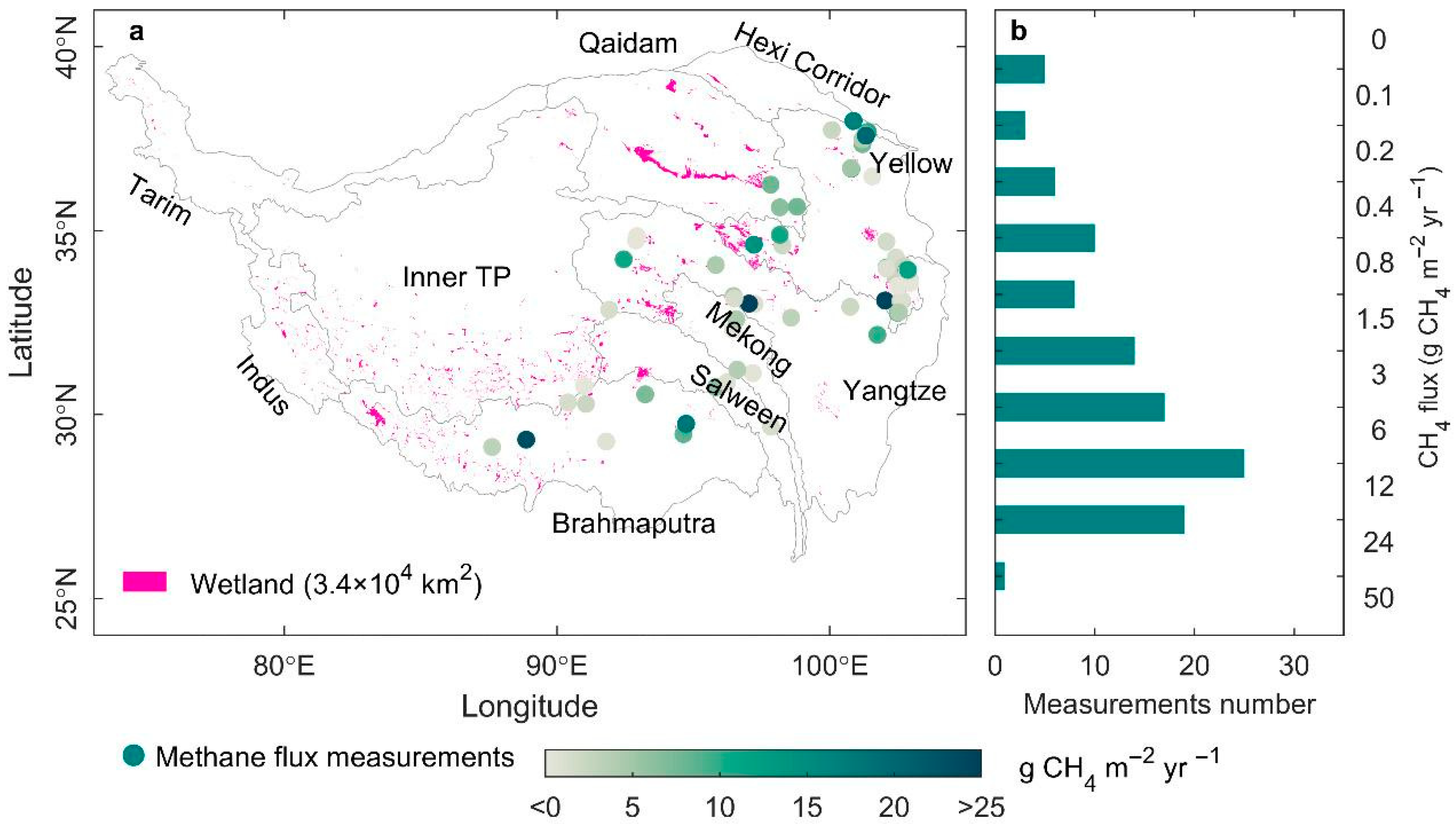
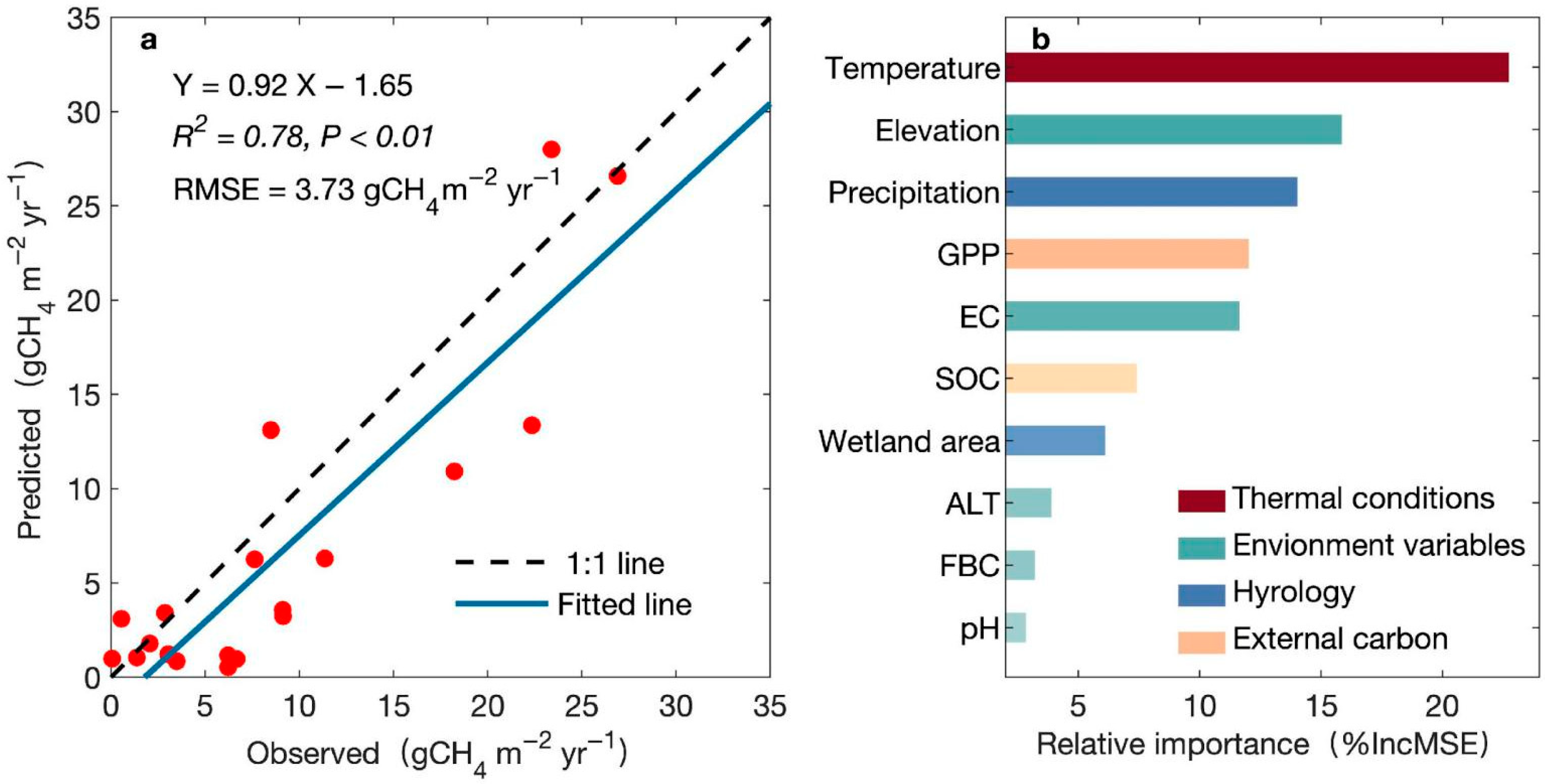
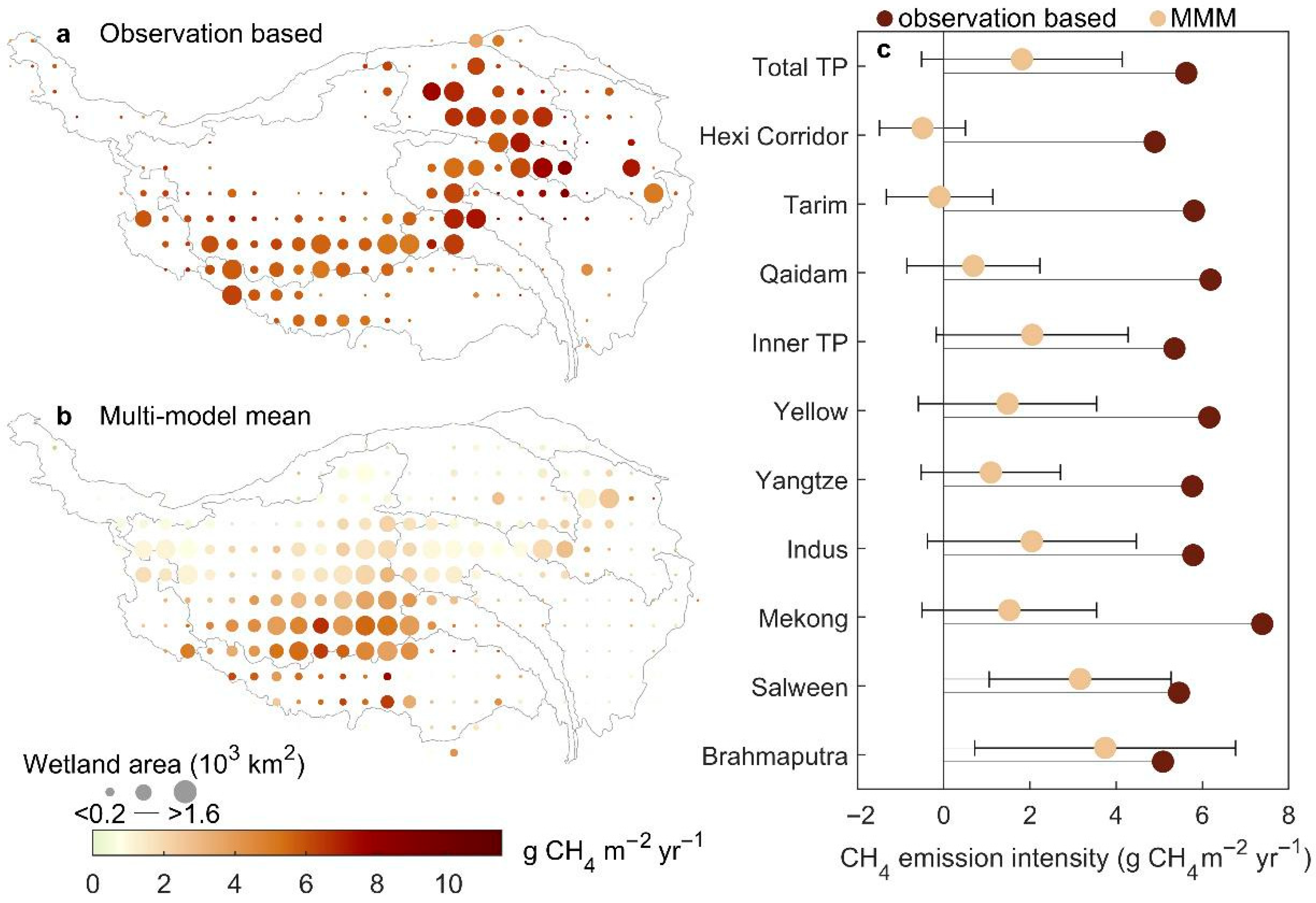

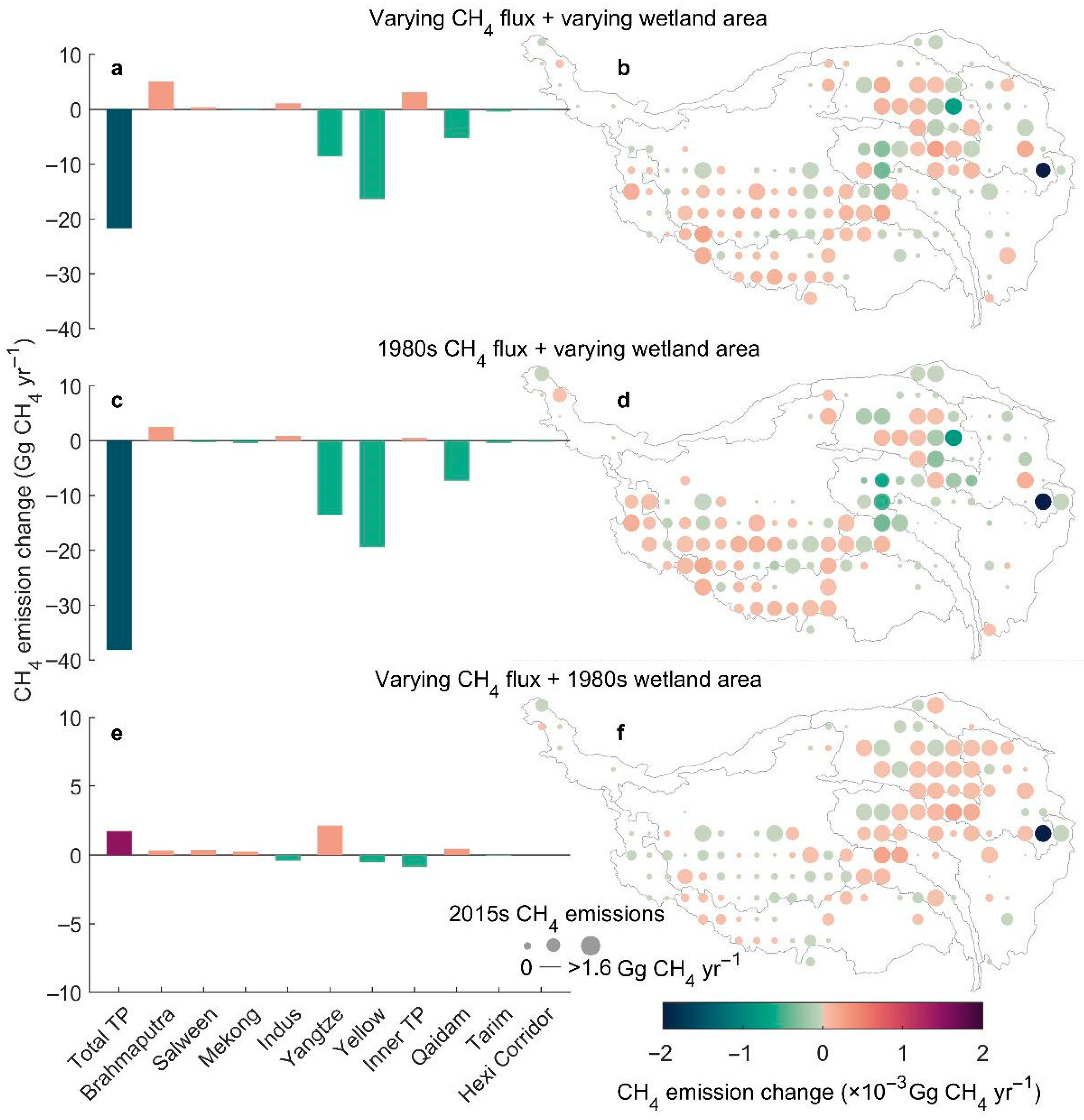
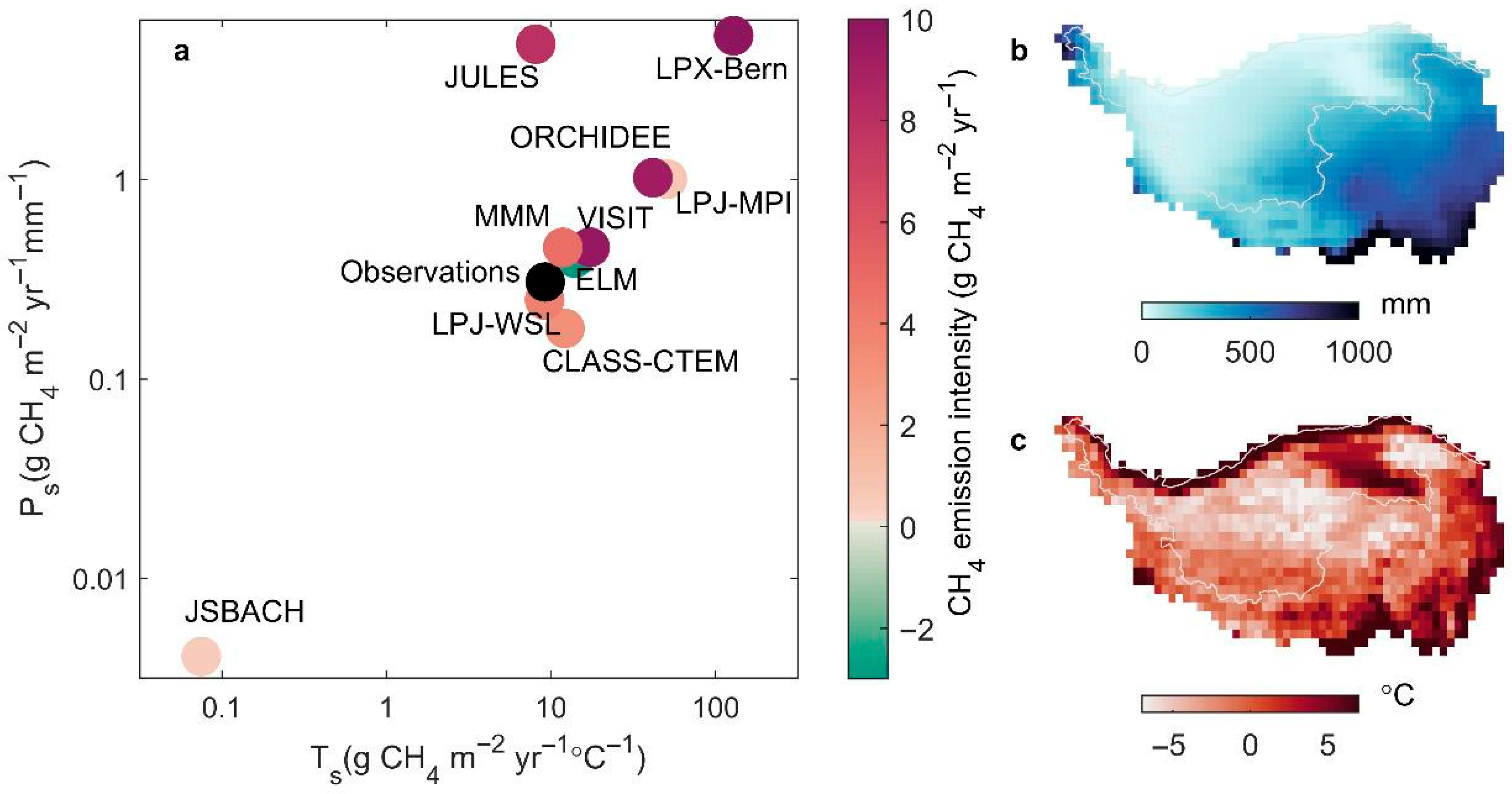
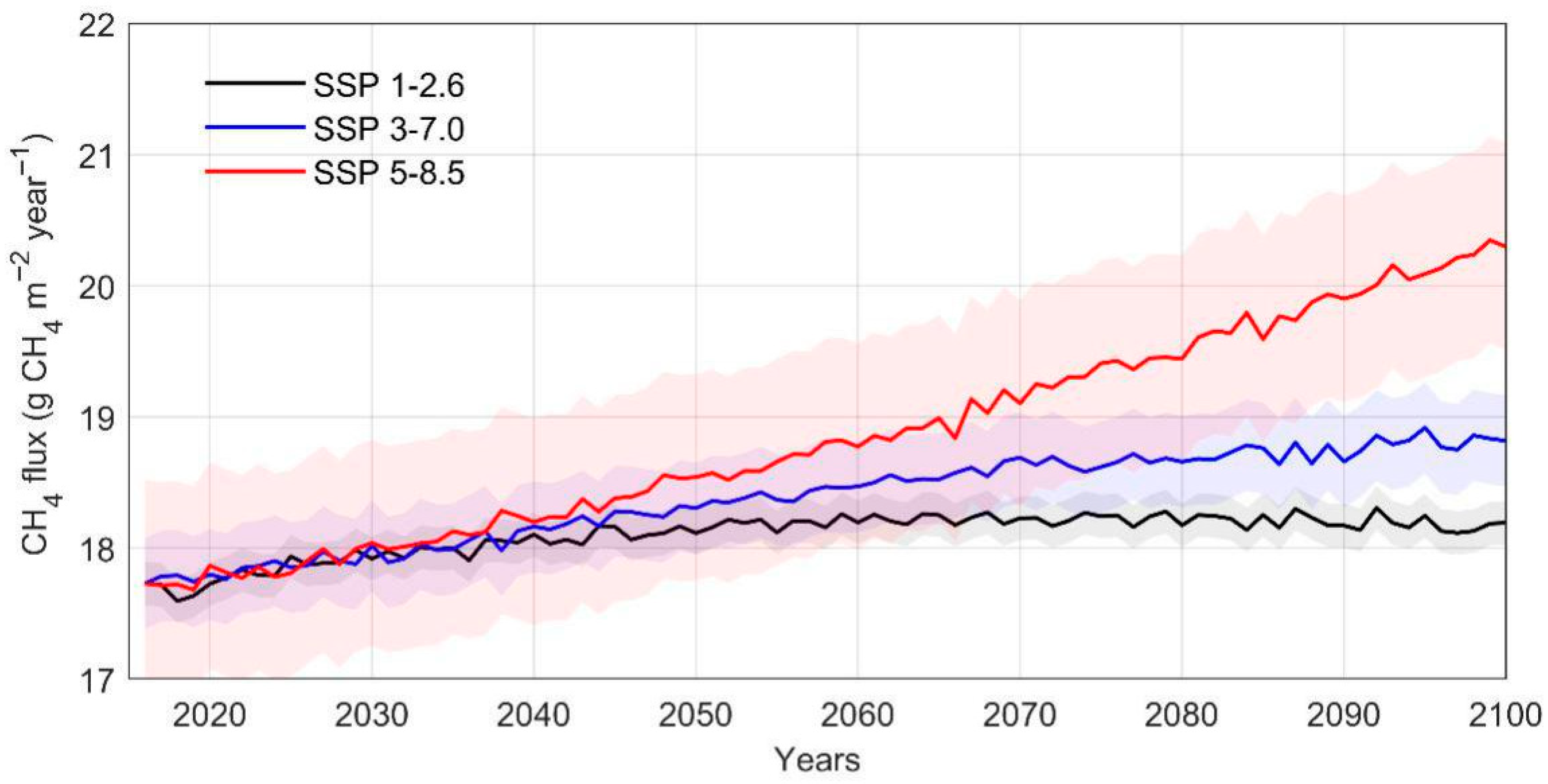
| Model | Institution | References |
|---|---|---|
| CLASS-CTEM | Environment And Climate Change Canada | Arora et al. (2018) [38] |
| ELM | Lawrence Berkeley National Laboratory | Riley et al. (2011) [39] |
| JSBACH | Mpi | Kleinen et al. (2020) [40] |
| JULES | Ukmo | Hayman et al. (2014) [41] |
| LPJ-MPI | Mpi | Kleinen et al. (2012) [42] |
| LPJ-WSL | Nasa Gsfc | Zhang et al. (2016) [43] |
| LPX-Bern | University of Bern | Spahni et al. (2011) [44] |
| ORCHIDEE | Lsce | Ringeval et al. (2011) [45] |
| VISIT | Nies | Ito and Inatomi (2012) [46] |
| Basin | 1978s (Gg CH4 year−1) | 2016s (Gg CH4 year−1) | 2100s (Gg CH4 year−1) | ||
|---|---|---|---|---|---|
| SSP1-2.6 | SSP3-7.0 | SSP5-8.5 | |||
| Brahmaputra | 9.6 | 16.9 | 16.6 | 17.1 | 18.5 |
| Salween | 2.74 | 3.14 | 3.07 | 3.17 | 3.42 |
| Mekong | 4.64 | 2.93 | 2.86 | 2.96 | 3.19 |
| Indus | 2.37 | 3.73 | 3.65 | 3.78 | 4.07 |
| Yangtze | 42.3 | 28.9 | 28.3 | 29.2 | 31.5 |
| Yellow | 75.3 | 37.2 | 36.3 | 37.6 | 40.5 |
| Inner TP | 29.4 | 35.2 | 34.4 | 35.6 | 38.4 |
| Qaidam | 17.0 | 13.7 | 13.4 | 13.8 | 14.9 |
| Tarim | 12.5 | 4.6 | 4.48 | 4.63 | 5.00 |
| Hexi Corridor | 1.94 | 0.84 | 0.82 | 0.85 | 0.91 |
| Total TP | 179.6 | 147.9 | 143.8 | 148.8 | 160.5 |
Disclaimer/Publisher’s Note: The statements, opinions and data contained in all publications are solely those of the individual author(s) and contributor(s) and not of MDPI and/or the editor(s). MDPI and/or the editor(s) disclaim responsibility for any injury to people or property resulting from any ideas, methods, instructions or products referred to in the content. |
© 2025 by the authors. Licensee MDPI, Basel, Switzerland. This article is an open access article distributed under the terms and conditions of the Creative Commons Attribution (CC BY) license (https://creativecommons.org/licenses/by/4.0/).
Share and Cite
Sun, T.; Jia, Z.; Zhang, Y.; Ying, M.; Shen, M.; Lyu, G. Methane Emissions from Wetlands on the Tibetan Plateau over the Past 40 Years. Water 2025, 17, 2491. https://doi.org/10.3390/w17162491
Sun T, Jia Z, Zhang Y, Ying M, Shen M, Lyu G. Methane Emissions from Wetlands on the Tibetan Plateau over the Past 40 Years. Water. 2025; 17(16):2491. https://doi.org/10.3390/w17162491
Chicago/Turabian StyleSun, Tingting, Zehua Jia, Yiming Zhang, Mengxin Ying, Mengxin Shen, and Guanting Lyu. 2025. "Methane Emissions from Wetlands on the Tibetan Plateau over the Past 40 Years" Water 17, no. 16: 2491. https://doi.org/10.3390/w17162491
APA StyleSun, T., Jia, Z., Zhang, Y., Ying, M., Shen, M., & Lyu, G. (2025). Methane Emissions from Wetlands on the Tibetan Plateau over the Past 40 Years. Water, 17(16), 2491. https://doi.org/10.3390/w17162491





